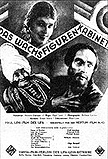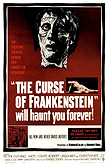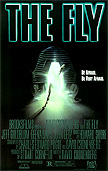Pre-Halloween Horror Film Day

Details:
Date: Saturday, October 23, 2010
Length: No set length
Type: Multiple series
Format: Open schedule
Releases:
• October 24, 2010.
October has been a tricky month for scheduling movie days. Everybody seemed to have had some big thing going on each weekend. Be it work, moving, or travel, it's been difficult to coordinate everyone together at the same time over the past several weeks. That's why there hasn't been a movie day since August 21.
Last night we picked back up where we left off. Typically the Saturday before Halloween is designated the Pre-Halloween Horror Film Day. We held this event in 2008 and 2009 (with a "Post" followup in '09). It's a day that is usually met with enthusiasm and finally gives Charles a chance to get his movies played.
For 2010, while I posted a mention of it a few weeks ago, I never followed up on it even when the 30th (next Saturday) became unavailable. The reason why it never came up again is because of what I discussed in the first paragraph above: peoples' schedules didn't seem to be lining up to make an event on the 23rd possible. Still, Charles was free and we decided to just have a "whatever" day and see what movies we wound up watching, whether they were horror films or otherwise.
What happened was that Paul, Dan, and Katie also showed up and we actually stuck to a horror film theme. In short, we wound up having Pre-Halloween Horror Film Day after all, despite it not being the intended consequence when we started out. Over the course of the afternoon and evening we watched Waxworks (dir. Paul Leni, 1924), The Curse of Frankenstein (dir. Terence Fisher, 1957), and The Fly (dir. David Cronenberg, 1986).
Here's a closer look at the movies we watched. I didn't mean to write an essay on the history of Hammer Horror but these things happen.
 |
Waxworks
(AKA, Das Wachsfigurenkabinett)
Neptune-Film A.G., 1924
Horror, B&W
Running time 63 minutes
Directed by Paul Leni
Staring William Dieterle, Emil Jannings, Conrad Veidt, Werner Krauss, Georg John, Olga Belajeff, John Gottowt, Ernst Legal
My rating:     
|
SYNOPSIS.
A poet (Dieterle) is hired by the owner of a wax museum (Gottowt) to write stories to accompany three historical figures: Harun Al-Rashid (Jannings), Ivan the Terrible (Veidt), and Jack the Ripper (Krauss). With the museum owner's daughter (Belajeff) by his side, the poet spins yarns about about these men.
MY REVIEW.
I've gone on about the German Expressionist era before, that decade-long movement in the history of cinema that arose out of the post-World War I, bankrupted, and humiliated German Weimar Republic. It represents the era between the fall of Kaiser Wilhelm II in 1918 and the 1932 rise of Adolf Hitler to the Chancellorship. Expressionism grew out of the Dadaist fad that arose in the art world, representing a disconnect with reality and a preference for the abstract. As an artform, Dada emphasized disorientation, odd angles, and a resistance to the rigors of the real world that the movement was forced to exist in. It was favored by the young, anti-war protesters in Germany, in large part rejecting the outdated preferences of their elders: elders whose outdated preferences caused World War I in the first place. It should come as little surprise that Dada survived and flourished in the ruined postwar Germany, evolving into the Expressionist movement in the burgeoning film industry.
Expressionism is generally thought to have began in 1919 with Robert Weine's The Cabinet of Dr. Caligari, a film that heavily employed abstract sets whose angles could not possibly align to reality and imagery that made no excuses for being roughly painted likenesses of the scenery they meant to represent. Knowing full well that the Pfennig-pinching postwar German film industry couldn't possibly match the extravagance of a Hollywood production, Expressionist filmmakers instead embraced stories that had to do with dreams, power, madness, psychoanalysis (as Freud was popular at the time), and a general rejection of the humdrum sanities of the normal world. All of this allowed for skewed realities and disillusionment, both of which were prime fodder for cheaply built sets in cheaply shot films that focused much more attention on the stories and screenplays than did their American counterparts.
For Waxworks in 1924, director Paul Leni reunited the two stars of Caligari, Conrad Veidt and Werner Krauss, for another go-round. As most of the film takes place in the free-for-all whimsies of the nameless poet's imagination, this is the perfect venue for Expressionism. The sets hearken back to Caligari, with bizarre painted angles and no claims to realistic representations of reality. The story, the imaginings of a creative mind, sculpt three distinct and two well-developed individuals: the Caliph, the Tsar, and the Ripper (Jack gets a bit short-changed in his brief, eleventh-hour sequence).
Waxworks was fairly short but covered a fair bit of ground and was great fun through and through. If I could offer only one critique it would be that the film is a bit disjointed, with the three stories essentially standing alone and unconnected with one another. The poet creates tales of Al-Rashid, Ivan, and Jack which, while all interesting and fun to watch in their own right, don't have anything at all to do with one another. Granted, this is the entire premise of the film and it seems a bit odd to then go and complain, but it's a minor quibble. The incongruity between movements, while to be expected, simply feels off but in the end does not have a tremendously negative impact on the work as a whole.
Expressionism effectively lasted until Fritz Lang's Metropolis in 1927, a film that I have written about at length. After Metropolis the German cinema began crawling out of debt and filmmakers no longer felt relegated to painted shadows on plywood façades. More lavish dramas became the norm.
|
 |
The Curse of Frankenstein
Hammer Film Productions, 1957
Horror, Color
Running time 83 minutes
Directed by Terence Fisher
Staring Peter Cushing, Christopher Lee, Robert Urquhart, Hazel Court, Valerie Gaunt, Melvyn Hayes, Paul Hardtmuth, Fred Johnson
My rating:     
|
SYNOPSIS.
Awaiting execution in prison, Baron Victor Frankenstein (Cushing) recalls how he and his former tutor, Dr. Paul Krempe (Urquhart), discovered a method of resurrecting the dead. Despite a falling out with Krempe, Frankenstein gradually gathers up the components necessary, by way of murder, grave robbery, and shady transactions, to built his ideal body and bring it back to life. What results is a homicidal monster (Lee).
MY REVIEW.
The Curse of Frankenstein began the second Great Period of monster movies. The first Great Period was in the 1930s and coincided with Universal's legendary monster series. Dracula and Frankenstein (both 1931), The Mummy (1932), and The Invisible Man (1933) launched this period, though it could be argued that The Phantom of the Opera (1925) was the progenitor of the series. This was the era of Lugosi and Karloff and most of the movies spawned sequels while many stand-alone films with similar themes were released.
The Universal series of the Thirties ended with The Wolf Man (1941), the last new original monster film to be released with only the lingering sequels stretching into this new decade. What made the monster boom of the 1930s so popular was the advent of sound. Neither Dracula nor Frankenstein would have been nearly as effective as silent films even in spite of both movies making rather spartan use of the new sound technology. Drawing heavily from tried and true German Expressionism (and employing emigres who fled Germany as Hitler came to power in the early 1930s), Dracula, Frankenstein, The Mummy, and those that followed merely Americanized the horror genre that had been so wildly popular overseas. Consider Karl Freund, set designer on Dracula and director of The Mummy. In Germany he had been the set designer on Murnau's The Last Laugh (1924) and Lang's Metropolis (1927), two of the quintessential Expressionist masterworks.
The 1940s did little to develop the genre but by the 1950s ideas were starting to change. Monster movies returned in force, fueled by the atomic age and fears of nuclear armageddon. American films like Them! (1954) became extremely popular and Japan became a film-making powerhouse after the release of Gojira (1954). Both films detailed the consequences of atomic testing and horrifying mutations wrought by nuclear fallout. In this decade when monster horror was revitalized -- but often marred by the campiness and unrealistic premises of the films -- a United Kingdom-based studio was able to target the market and open up the second Great Period of monster films.
Enter Hammer Film Productions, a low-budget British studio that had previously plugged along making unmemorable dramas. An experiment in horror, The Quartermass Xperiment (1955) was a huge success, prompting Hammer execs to invest more interest in the genre. Returning to the American films made twenty-five years prior, Hammer revived the monster movie genre using Universal's much-loved classics as their basis. Within three years Hammer produced their own versions of Frankenstein (1957), Dracula (1958), and The Mummy (1959). Each film, like their 1930s counterparts gave rise to a stream of sequels and became immensely popular in their own right and, where Universal took advantage of the new sound technology, each of Hammer's films was in glorious color at a time when most comparable movies were still being shot in cheaper black and white. A new generation was introduced to the old classics while modern versions were being created with a respect, sensibility, and aesthetic that almost seems like a logical evolution of the Universal series.
As time progressed and censors lifted the bounds of what's acceptable on film, the Hammer films contained far more blood and violence than the more-or-less bloodless and tame Universal oldies, but a core belief -- that a good monster movie should be honest and realistic -- remained. Like the Universal films (or, at least, the first films in each of Universal's individual series), Hammer's monsters were at once terrifying and surreal while still inhabiting a perfectly believable world free from campy plots, ridiculous situations, and unnatural characters. If we can believe that the Dr. Frankenstein played by Colin Clive in the 1931 film created a monster (Boris Karloff), then Hammer's 1957 version is no different: we fully believe that Peter Cushing's Baron Frankenstein similarly created his own monster (Christopher Lee). Perhaps the believability factor even sides more with Cushing than with Clive in terms of execution.
The Curse of Frankenstein was Hammer's first foray into the monster movie genre and gave rise to the prolonged series that followed, known as Hammer Horror. This take on Frankenstein is much more restrained than its Universal forebear. Absent is Colin Clive crying out, "It's alive!" Instead Cushing is cool, never to break into exaggerated exclamations, even as his world crumbles. Absent too is the hunchback sidekick, Fritz or Ygor, played by Dwight Frye in 1931. Instead there is Urquhart's Paul Krempe, the consummate, straight-spined professional. Here we are without the Karloff monster, with neck bolts, high and flat head, maze of stitches, and slow lumbering gait. Instead there is Lee's monster, sans neckbolts and flat top, but a grotesque mishmash of stitched-together flaps of flesh and slightly faster lumbering gait.
All said, it may be a futile exercise to try and compare the Universal and Hammer versions of Frankenstein. Both stand alone in their own right in terms of quality, iconic imagery, and effect on the genre. While we may look back on James Whale's 1931 masterpiece as THE Frankenstein film for the ages, and I would be wary of arguing that case, Terance Fisher's 1957 work is just as masterful and just as ageless.
Today, fifty-three years after Hammer Horror began, we find ourselves in the third Great Period of monster movies. The genre is popular once more, though some may argue just how "great" it is, considering the nauseating popularity Twilight books and films. Ostensibly this third period began in the early 1990s with the release of Francis Ford Coppola's Bram Stoker's Dracula (1991), with the other Universal and Hammer icons being revived in Kenneth Branaugh's Mary Shelley's Frankenstein (1994), Stephen Summers' The Mummy (1999), and Joe Johnston's The Wolfman (2010). Unlike the previous two major periods, there is no single studio heading the trend. None of the films represent a distinct series and each take favors a separate ideology (compare Buffy to Twilight, for example). What has resulted is a massive number of competing monster movies, with no inherent connection to one another, all of them contradicting the others. Moreover, few have been actually memorable, the majority being composed of weak or derivative stories that lack the ability to stand on their own or have any lasting potential. This period can be considered "great" only on the sheer number of titles being released ... not on the actual quality of the works.
Seeing that the big trends on monster movies tend to come around every thirty to forty years, with each cycle lasting anywhere from fifteen to twenty, we can possibly expect another monster craze around 2040 or 2050. Hopefully those future movies will be better than today's and spell out a truly astounding fourth Great Period of monster movies.
|
 |
The Fly
Brooksfilms/20th Century Fox, 1986
Sci-Fi/Horror, Color
Running time 95 minutes
Directed by David Cronenberg
Staring Jeff Goldblum, Geena Davis, John Getz, Joy Boushel, Leslie Carlson, George Chuvalo, Michael Copeman, David Cronenberg
My rating:     
|
SYNOPSIS.
Seth Brundle (Goldblum) is a scientist who has seemingly done the impossible by inventing a teleportation device. After revealing his invention to science journalist Veronica Quaife (Davis) -- who reveals it to her cynical boss (Getz) -- and testing it successfully on a chimp subject, Brundle steps into the machine. Unfortunately, a housefly buzzes into the chamber and Brundle is genetically merged with the insect, beginning a horrific transformation into a radical new species: Brundlefly.
MY REVIEW.
Following on the heels of Waxworks and Curse of Frankenstein, there isn't much that I feel I can say about The Fly. At the very least, I haven't a lengthy history about its place in cinema.
The Fly is a weird movie. It's an updated version of a 1958 horror flick that, while the older movie stands well on its own two feet, began to feel a little bit dated. Specifically, the special effects and prosthetics that transformed David Hedison's character of Andre Delambre into a creature with the head and arm of a fly, seemed woefully unlifelike by 1986's standards. Monster movies were fairly popular during the 1980s, with An American Werewolf in London (1981), Teen Wolf (1985), and The Monster Squad (1987) being a few of the more stand-out examples. Combine this with the gross-out and shock value that films were now being allowed to get away with, and it seems perfectly sensible that someone would revisit The Fly.
That that someone was David Cronenberg seems all the more appropriate. This was just three years after Cronenberg filmed Videodrome (1983), a twisted, disgusting, completely disturbing, and generally entertaining trip into the nightmarish hell that David Cronenberg alone considers normal. The Fly is more of that, only this time without cannonballing off the deep end of sanity and then proceeding to relieve itself in the pool. No, The Fly is simply disgusting and disturbing, horror at its oozing finest, without Videodrome's unfortunate side effect where you find yourself breaking into tears at the slightest provocation for years after.
Jeff Goldblum is at his best when playing eccentric, keyed-up scientists and engineers and, as such, he shines here as Brundle. Looking back on Goldblum's career, from the more recent rose-tinted glasses of Ian Malcolm, David Levinson, and Allistair Hennessay -- sometimes pompous but ultimately harmless individuals -- the character of Seth Brundle is a bit of a shock, adding an extra level of disturbing by virtue of hindsight. It feels as unnatural for Jeff Goldblum to be spending this days having rough sex and being prone to fits of uncontrolled violence as it is for him to be transforming into a fly creature, crawling on the ceiling, and vomiting digestive fluids onto people.
The Fly is delightful horror at its absolute nastiest. It is absolutely disgusting, completely unsettling, and altogether terrifying. There's no need to consider how plausible it actually is, as that would only hamper the enjoyment of watching. I grew up with The Fly, and have many fond memories of it. Seeing it again after several years was a reminder to why this is one of the great horror and gross-out films.
|
|







